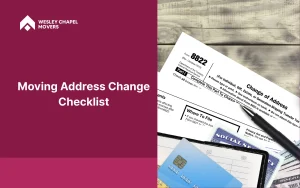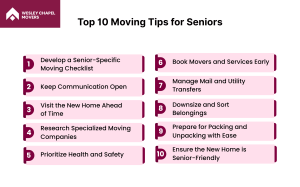Planning a successful apartment move means completing over two dozen critical tasks across multiple weeks, from giving your landlord proper notice to setting up your new home’s utilities. Without a structured plan, it is easy to forget important steps or run into costly delays. That is why a time-based moving checklist helps renters stay in control by distributing each task to the right phase in the process.
The apartment moving checklist is organized into weekly intervals that begin as early as 8 weeks before move-out day. Each phase includes focused actions such as researching moving companies, scheduling donations, packing non-essentials, or confirming insurance. Assigning tasks to logical points in time helps reduce stress, prevent last-minute rushing, and ensure nothing falls through the cracks.
As the move progresses, the checklist shifts focus to execution and post-move setup. It prompts renters to supervise the move, complete the final walk-through, unpack essentials, and arrange furniture for day-one comfort. This structured approach is especially valuable for those coordinating long-distance logistics or juggling work, family, and tight schedules while relocating.
What is an Apartment Moving Checklist?
An apartment moving checklist is a week-by-week planning tool that helps renters manage more than 25 essential moving tasks, including notifying the landlord, researching movers, transferring utilities, and unpacking after the move. It assigns each action to a specific period, starting 8 weeks before the move and continuing through move-in day and post-move setup. This structure ensures no critical steps are missed and helps renters maintain control throughout the process.
The checklist is tailored for practical use, including time-sensitive actions like creating a moving folder, reserving a truck, packing non-essential items, and updating your address with USPS (the United States Postal Service). Each task is positioned for maximum efficiency, reducing the chance of last-minute issues. By spreading responsibilities across a clear timeline, the checklist simplifies planning, reduces stress, and keeps the entire move organized from start to finish.
Why is an Apartment Moving Checklist Important?
An apartment moving checklist is important to stay organized, reduce stress, save time, and avoid missed tasks, providing a clear and structured approach to the moving process. Without this checklist, renters often find themselves scrambling to handle last-minute tasks, which can lead to costly mistakes or forgotten responsibilities like notifying the landlord, booking movers, and transferring utilities. By breaking the moving process into manageable steps, this tool ensures each task is accounted for and completed on time, resulting in a smoother, more efficient move. Here is how it helps:
- Staying Organized
- Having a moving checklist ensures that all tasks are documented and organized in one place, making it easier to stay on top of each responsibility. From packing non-essentials well in advance to confirming travel arrangements, the checklist provides a clear sequence of steps. This structure eliminates the chaos of trying to remember everything at once and helps renters focus on completing each task on time.
- Reducing Stress
- One of the main benefits of a checklist is that it directly helps reduce stress by providing a clear, visual timeline for every action that needs to be taken. When renters follow the checklist, they avoid the feeling of being overwhelmed by the number of tasks that often come with a move. By spreading tasks across a well-defined timeline, the process becomes much more manageable, leaving renters feeling in control rather than stressed.
- Saving Time
- By providing clear deadlines for each task, the checklist helps renters save time by ensuring critical tasks are completed ahead of schedule. By booking movers early, organizing packing supplies well in advance, and managing other preparations in an orderly fashion, renters avoid last-minute scrambling. This results in a smoother moving day, where renters have more time to focus on coordinating logistics and settling into their new space.
- Avoiding Missed Tasks
- Using an apartment moving checklist is essential for avoiding missed tasks, such as changing the address with USPS or setting up utilities. When renters follow the checklist, they ensure that every necessary task is completed at the right time, eliminating the risk of forgetting something vital, like confirming the final walk-through or packing essentials.
- Tracking Progress
- With an apartment moving checklist, renters can easily track progress as each task is completed. By checking off items on the list, renters can visually see how much has been accomplished and how much is left to do, helping them stay on top of the moving process. This progress tracking offers motivation and reassurance, reducing any anxiety related to the unknowns of moving.
- Helps with Budgeting
- The apartment moving checklist supports budgeting by prompting renters to book services early and track moving-related expenses. It also assists in planning for essential purchases like packing supplies or temporary lodging. This budgeting structure ensures that renters avoid unexpected costs and can allocate resources more effectively, keeping the move financially manageable.
- Ensures a Smooth Transition
- By following the apartment moving checklist, renters can ensure a smooth transition to their new apartment. From confirming the arrival time of movers to setting up basic utilities, having a well-organized plan helps avoid the stress of last-minute issues and ensures that everything is ready for move-in day. A checklist guarantees that the transition is seamless and efficient.
- Preventing Last-Minute Rush
- An apartment moving checklist is critical for preventing the last-minute rush that often accompanies moving. With tasks spread out over several weeks, renters can tackle smaller responsibilities in advance, avoiding the stress of trying to pack or arrange last-minute details on the day before the move. This proactive approach helps ensure that renters are not scrambling to get everything done just before the big day.
What is Included in an Apartment Moving Checklist?
An apartment moving checklist includes essential tasks such as notifying your landlord, researching and booking a moving company, setting up utilities like electricity, water, and internet, and packing non-essentials well ahead of time. It also outlines the preparation of an essentials box for your first night and tasks like changing your address with USPS. Post-move responsibilities, such as organizing your new apartment and ensuring everything is set up, are also included. By listing each task and its corresponding timeline, the checklist ensures nothing is missed, providing clear guidance through every stage of the move.
Step 1: 8 Weeks Before the Move
Notify Your Landlord
Notify your landlord 60-90 days before moving, as required by most lease agreements. The notice must be provided in writing, either hand-delivered or mailed, even if your rental agreement was oral. Clearly state your move-out date and confirm any specific move-out procedures to avoid penalties or misunderstandings. Always keep a copy of the notice for your records.
Create a Moving Folder
Start a moving folder to keep all relevant documents organized, such as lease agreements, moving company quotes, and utility transfer forms. This will make it easier to track important information as the move progresses.
Start Researching Moving Companies
Begin researching and comparing moving companies, looking at reviews, services offered, and cost estimates. Booking early ensures availability, especially during peak moving seasons.
Declutter Your Home
Declutter by sorting through your belongings and deciding what to keep, donate, sell, or throw away. The earlier you start, the easier and less stressful packing will be.
Change Your Address with USPS
Submit a change of address request to USPS so your mail will be forwarded to your new apartment. This should be done at least 2 weeks before moving to ensure smooth mail transition.
Start Preparing Your Utilities
Contact utility companies (electric, water, gas, internet) to schedule service transfers or disconnections for your current apartment and set up service at your new address. Early preparation ensures no service interruptions.
Create a Moving Budget
Draft a moving budget to track expenses such as moving company costs, packing materials, and any potential temporary lodging. This will help keep your move within financial limits.
Reserve Hotel or Temporary Lodging (if moving long-distance)
If you are moving long-distance, book temporary lodging for your travel dates. Reserving a hotel or Airbnb early can save money and ensure you have a comfortable place to stay during the move.
Step 2: 6 Weeks Before the Move
Gather Packing Supplies
Start collecting boxes, tape, bubble wrap, and markers. Consider using recycled boxes or free materials from local stores to save on packing costs. Having supplies early ensures you are ready to begin packing.
Begin Packing Non-Essential Items
Start packing items that you will not need before moving day, such as seasonal clothing, decor, and extra kitchenware. Label boxes by room to make unpacking easier.
Create a Packing Plan
Organize your packing by room or category (e.g., kitchen, bedroom, office). Create a schedule to pack a little each day, preventing last-minute stress and ensuring a more manageable moving day.
Schedule a Donation or Garage Sale
Plan a donation drop-off or a garage sale to get rid of unwanted items. This helps declutter your home, reduces moving costs, and may even earn you some extra money.
Set Aside Important Documents
Gather important documents like birth certificates, medical records, and financial papers. Keep these in a safe, accessible folder so they are easy to find during the move.
Pack Essential Items for Moving Day
Pack a box with items you will need immediately after the move, such as toiletries, clean clothes, and basic kitchenware. This will ensure you can settle in comfortably on day one.
Research Your New Community
Research your new community to find grocery stores, medical facilities, schools, and transportation options. This helps you feel more settled and informed when you arrive.
Book Movers or Rent a Truck
Confirm your moving company or rent a truck if doing the move yourself. Book early to secure availability and compare costs for the best options that suit your budget and timeline.
Step 3: 4 Weeks Before the Move
Confirm Moving Company or Truck Rental
Confirm the details with your moving company or truck rental to ensure the reservation is secured. Verify the moving date, arrival time, and any additional services required for the move.
Pack the Remaining Items
Begin packing your everyday items and remaining non-essentials, including clothes, kitchenware, and any seasonal items you will not need before the move. Make sure all items are packed well in advance.
Prepare an Essentials Box
Pack a box of immediate necessities that you will need upon arrival, such as toiletries, medications, chargers, and basic cleaning supplies. Keep this box easily accessible on moving day.
Complete Any Change of Address
Update your address with USPS, banks, credit card companies, and any subscriptions. Ensure all mail is forwarded to your new address, which will help avoid any delays or missed deliveries.
Transfer Utilities
Schedule the transfer or activation of utilities (electricity, water, gas, internet) to your new apartment. Confirm the dates to ensure services are available when you arrive.
Confirm Insurance Coverage for Move
Contact your insurance provider to confirm your coverage for the move. Ensure that both your belongings and the moving process are insured to avoid unexpected issues or damages during transit.
Notify Medical Providers and Transfer Prescriptions
Notify your medical providers about the move and arrange for any necessary prescription transfers to a new pharmacy. This ensures continuity of care and avoids delays in medication.
Set Up Internet and Cable Services
Schedule the installation or transfer of internet and cable services. Confirm dates for setup, so you have access to communication and entertainment as soon as you arrive at your new apartment.
Step 4: 2 Weeks Before the Move
Confirm All Moving Details with Movers or Helpers
Double-check all moving details with your moving company or helpers. Confirm the arrival time, moving address, and any special requirements for the move to ensure everything goes smoothly.
Supervise the Packing Process
Oversee the packing process to ensure everything is properly packed and protected. Make sure all boxes are labeled clearly by room or category, and that fragile items are packed securely.
Handle Last-Minute Tasks
Take care of any last-minute tasks like canceling unused services, returning keys, and wrapping up home repairs. Complete any necessary administrative tasks that could delay the move or the move-out inspection.
Complete Final Walk-Through of Current Apartment
Perform a final walk-through to check for damages, ensure everything is packed, and confirm the apartment is clean. Take photos or document any issues to avoid disputes with the landlord.
Arrange for Pet and Childcare (if needed on moving day)
If you have pets or children, arrange for pet care or childcare during the move to minimize distractions and keep everyone safe. This allows movers to work efficiently without interruptions.
Confirm Travel Arrangements for Long-Distance Moves
For long-distance moves, confirm travel arrangements such as hotel bookings, vehicle rentals, or flights. Ensure accommodations are secured, and the travel plan is set for a smooth transition.
Moving Week (Final Preparations and Moving Day)
In the final week, complete all last-minute packing, confirm that all documents and essentials are ready, and double-check the moving schedule. Make sure the moving team has clear instructions for a smooth move-in day.
Step 4: Final Packing
Confirm Moving Details Again
Double-check all final moving details with the moving company, such as arrival time, addresses, and special instructions. Confirm any last-minute changes to avoid confusion on moving day.
Prepare Your Essentials Box (items for the first day in your new home)
Pack an essentials box with items you will need immediately after the move, such as toiletries, clothes, medications, and important documents. Keep it accessible to make your first day in the new home more comfortable.
Do a Final Walk-Through of the Current Apartment
Conduct a final walk-through of your apartment to ensure everything is packed and nothing is left behind. Check for any damage and take photos for your records to avoid disputes with the landlord.
Supervise the Loading Process
Oversee the loading process to ensure all items are handled with care and packed properly. Confirm that everything is loaded safely, and fragile items are given special attention.
Finalize Utility Transfers for New Apartment
Ensure that all utility transfers (electricity, water, gas, internet) are confirmed and active for your new apartment. Check the activation dates and set up any final installations before you arrive.
Step 5: Moving Day
Confirm All Details with Movers/Helpers
Confirm the moving time, addresses, and special instructions with your movers or helpers. Ensure all details are clear to avoid delays or confusion during the move.
Supervise the Move
Stay present and supervise the move to ensure everything is handled correctly. Ensure all items are safely loaded and labeled properly for easy unpacking at the new apartment.
Complete the Final Walk-Through of the Old Apartment
Before leaving, do a final walk-through of your old apartment to ensure you have not missed anything. Check for any damage and confirm the apartment is clean, as required by your lease agreement.
Arrive at the New Apartment Early
Arrive early at your new apartment to inspect the space and ensure everything is ready for the movers. Take time to check for any issues or areas that need attention before they arrive.
Supervise the Unloading of Items
Oversee the unloading process to ensure items are placed in the correct rooms. Check that boxes are not damaged and fragile items are handled with care during the move-in process.
Step 6: After the Move
Unpack Essentials First (toiletries, clothes, kitchenware)
Unpack essential items such as toiletries, clothes, and basic kitchenware right away. This ensures that you have everything you need to settle in on the first day and night in your new home.
Check for Damages to Furniture and Apartment
Inspect your furniture and the new apartment for any damage. Document any issues immediately, especially if items were damaged during the move, and contact the moving company or landlord if necessary.
Set Up the Bed and Bathroom
Set up your bed and bathroom first to ensure you have a comfortable place to sleep and freshen up. This will make the first night in your new apartment much easier and more comfortable.
Organize Your Kitchen
Unpacking essential items like dishes, utensils, and small appliances for your kitchen to ensure you can prepare meals and get the kitchen functional quickly.
Arrange Furniture and Decor
Start arranging your furniture and adding decor to make your new apartment feel like home. Place large items in their designated rooms and add personal touches like pictures and plants to create a welcoming atmosphere.
Step 7: Final Tasks
Change Your Address (Banks, Credit Cards, etc.)
Update your address with banks, credit card companies, and other important services to ensure you receive all mail and billing information at your new address. Do not forget to update any subscriptions or online accounts as well.
Transfer Utilities to New Apartment (if not already done)
Confirm that all utilities (electric, water, gas, and internet) have been transferred to your new apartment. If this has not been done yet, contact your utility providers to ensure services are set up and active.
Register Your Vehicle (if moving to a new state)
If you are moving to a new state, register your vehicle with the local Department of Motor Vehicles (DMV) and update your driver’s license and vehicle insurance. Complete this process within the required timeframe to avoid legal issues.
What Are The Best Practices for Using an Apartment Moving Checklist?
The best practices for using an apartment moving checklist include personalizing your checklist, prioritizing tasks, breaking tasks into manageable steps, and updating the checklist as you go. These strategies help streamline the moving process, keep you organized, and ensure nothing is missed. Following these practices will make the move more efficient and less stressful. By staying flexible and adapting as you progress, you will maintain control and stay ahead of any unexpected challenges.
- Personalize Your Checklist
- Tailoring your checklist to your unique needs ensures that it reflects your specific moving situation. Consider factors like the size of your home, the distance of the move, and any special circumstances (such as moving pets or delicate items). For example, if you are moving to a different city or state, you might need to schedule services like utility transfers and travel arrangements. Customizing your checklist ensures that you focus on the tasks most relevant to your move, helping to avoid unnecessary confusion.
- Prioritize Tasks
- Starting with the most urgent tasks allows you to focus on what matters most first. For example, securing movers or booking a truck rental should be done as early as possible, as these services tend to book up quickly. Additionally, important actions like notifying your landlord or changing your address need to be handled early to prevent delays. By identifying high-priority tasks, you ensure that critical steps are completed on time, minimizing stress and preventing last-minute scrambling.
- Break Tasks into Manageable Steps
- Dividing large tasks into smaller, more manageable ones makes the entire process feel less daunting. Instead of writing “pack the entire house,” break it down into steps like packing the kitchen, sorting out clothing, and organizing books. By giving each smaller task a deadline, you can make steady progress without feeling overwhelmed. This approach turns a seemingly overwhelming project into a series of achievable steps, making it easier to stay on track.
- Update the Checklist as You Go
- Keeping your checklist flexible and up-to-date ensures that it remains an accurate reflection of your progress. As tasks get completed, mark them off, and be sure to add any new tasks that come up. For example, you might realize that you need to arrange for pet care or schedule a last-minute cleaning service. Continuously updating the checklist allows you to stay adaptable, track what is left to do, and maintain a sense of accomplishment as you check off completed tasks.
Ensure a Smooth Move with the Right Apartment Moving Checklist
Using the right apartment moving checklist helps notify your landlord, research and book movers, pack non-essentials, and set up utilities in advance, ensuring that every task is covered and nothing is overlooked. A detailed checklist breaks down the moving process into manageable steps, allowing you to stay organized, reduce stress, and avoid last-minute issues that can arise during a move.
A well-executed checklist, combined with professional apartment moving services like Wesley Chapel Mover’s guarantees a seamless move. Our team of experts can handle everything from packing your belongings securely to loading, transporting, and unloading with efficiency and care. With Wesley Chapel Mover’s, you can trust that all aspects of your move will be taken care of, allowing you to enjoy a stress-free transition to your new apartment.







